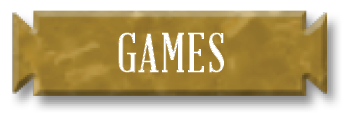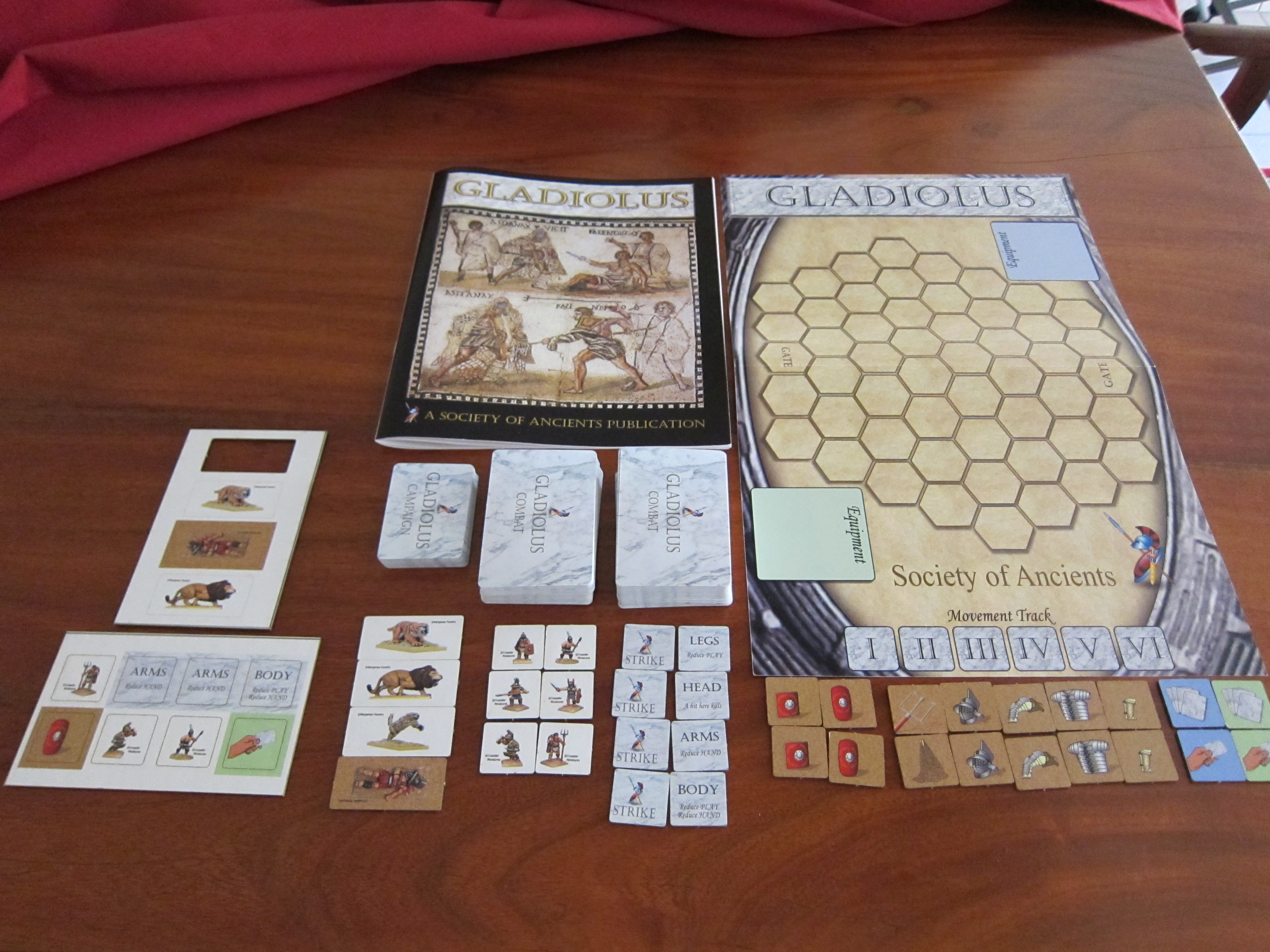 |
Gladiolus£20This game of classical single combat is for two players who each have either a gladiator or a wild animal. Play is challenging and entirely without dice, relying upon a player’s ability to outmanoeuvre and bluff his opponent. Games are fast, with a typical combat taking 10-15 minutes and an entire multi-combat tournament can be conducted in an evening. In our hearts, who is not, in some way, Spartacus? This luxury remake of the Society’s most successful board game includes sturdy, pre-cut counters and no fewer than 140 ready-to-go cards – no cutting and pasting required. Suitable for ages 12 upwards. |
The Society of Ancients is re-releasing the game Gladiolus. This is a game of gladiatorial combat for two players (or one player and his imagination) using a hex grid arena, gladiator tokens and card decks for movement and tactics.
Each player draws a hand of cards (six for each gladiator type except the heavily-armoured Samnite and Hoplomachus, who each draw four) sight unseen from his deck of thirty (twenty for the Samnite and Hoplomachus). At the start of each turn, each player chooses a card to represent his defence for that turn and places it face down. This Hole Card represents his defensive effort for that turn, but there are only so many good defensive cards in the game, and they should be used wisely.
Players move in sequence, as determined by their Speed (actually initiative) rating. The first player uses up to three (two if Samnite or Hoplomachus) cards for his moves and attacks (some cards allow movement; some allow move and attack) and sees if any of his attacks get past the other player's Hole Card. If so, each attack is resolved with Attack cards (used by the attacking player) and Defence cards (used by his opponent), the aim of the latter being to try and match the area (head, arms, body or legs) that is the target of the attack. This is repeated for each attack which is not blocked by the Hole Card. Successful attacks can kill but usually injure an opponent, injuries penalising the number of cards a player can hold, or play, or both. If either drops to zero, that gladiator is down and has lost (but survives and may take part in future bouts). If a killing blow is landed, the victim is dead and (obviously) loses the match.
The player draws replacement cards at the end of his turn, up to the number allowed in his hand (initially six or four, but injuries can change this). Once the first player has taken his turn, the second player does so, with the first player now attempting to defend if his hole card fails to block attacks. The skill in this game is making the best use of the cards you have in hand, and anticipating what your opponent might do. The fun lies in how involved with the sweat, blood, flashing blades, anticipation, thrill of combat and optional imaginary oiled torsos a player wishes to be.
We now move to the arena for a contest to be played out before our very own eyes.
Ave editor! Ave cives!
I am Neptunius, a gladiator in the Gladiolus arena. Today you shall see me in combat, for better or worse. I am a retiarius, which as any schoolboy knows (or should know) is a gladiator equipped with a net, a trident and a leather harness which reveals a lot but protects nothing. I shall be fighting a typical opponent, Crixus the secutor.
So here we are, standing in the arena. Unlike the arena in Rome, which is floored with sand, the Gladiolus arena is floored with hex-shaped tiles, but cleaning up the blood is just as easy and happens automatically between bouts. (Actually I suspect it is done by slaves using big sponges on big sticks, but I never had the chance to hang around and find out.) In front of me is my hand of cards, six of them drawn from a hand of thirty. Let's see what we have. Well, bifurcate me with a Batavian broadsword, a Dodge card! Handy one this: it negates all your opponent's attacks during a round. Only three of them in my pack, so I hang onto this one. Move card, no surprises there as they form about half the pack; another move card, Swing Net card, good, I need one of those; I say, bisect me bilaterally with a burnished Bastanae battleaxe, another Dodge card, and finally another Move card.
Right, one of these has to be used as the Hole Card, which represents your defensive tactic of choice for the round. However on round one nobody is going to hit anyone else, so I shall dump a Move card into the Hole and save my Dodges and Swing Net for when it is up close and personal.
Ah, Crixus has finished looking through his cards, a major achievement for one of his intellect, so on to the first round. I have a Speed (initiative) rating of 3 and his is 4, so he goes first. He can play two cards and look at that! A Move and a Rush, closing three hexes of the six which separate us. He also put a Move card as his Hole card, so that does nothing. And there he goes, picking up another three cards to make up his hand. There goes his new Hole card – can;t see what it is, but judging by the expression on his face it is a Dodge or Shield, either of which would stop my attacks as surely as a desperate Dalmatian darter's door-shield.
My turn, then. Up with the Hole card, which is basically a throwaway; I now play Move and Move, going two towards him as this will encourage him to close and play a lot of attack cards which I shall simply Dodge. Take three new card from the pack: well, burden me with a bicruciform Belgian basilica, it's the third Dodge card! And another Swing Net – and finally a Move. No extra attack cards as yet, so we shall have to rely on Final Attacks here. This just means if I am standing next to him at the end of the round I get to poke him with my sharp pointy thing. OK, Hole card down (it's a Dodge) and we shall see what he makes of that.
His second turn. His Hole card is not revealed until I make my attack, but he is playing a Slash card and an Armour card to go with his Final Attack – typical Crixus, as the Armour card is only useful against opponents wearing armour, whereas I am as exposed as a nymph in the Nymphaeum on a hot summer day. I anyway play my defence card, Arms, because I know my Dodge will cancel his attacks, leaving me as safe as a Savernian pork sausage on a Jerusalem market stall, so I just take the chance to mislead him about what I am likely to defend. Well, he goes for Body on the Slash and Legs on the Final - and misses completely thanks to my Dodge, his Slash and his Final Attack both having as much effect as a love letter to a vestal virgin. He picks up three more cards, and that is that for his turn.
My turn. I think he has a Shield or Dodge as his Hole card, so I waste none of my cards (the Swing Net being the only card I could use), pick one to replace my Hole card and do my Final Attack, and his Hole card is Shield so, as expected, my Final Attack is wasted. My replacement card is a Move card – my attack cards must all have migrated to the bottom of the pack. I could use a good Prod next round. Another Dodge for my Hole card, and on to his third turn.
Two Slashes this time: his card deck must be the inverse of mine. Must have a word with the fellows who shuffle them between bouts, I think they are falling down on the job. I defend Arms each time, as it makes no difference at all because of my Dodge, so both his Slashes and his Final Attack have no more effect than a Greek grape on a gorgon, and he has a scowl on his face as he draws three more cards from his deck, as he knows he is out of Slashes. He probably hoped to finish me off that round.
My turn: I play a Swing Net to see if he has bothered with any decent defence cards, and his Hole card turns out to be Armour: realising it is useless against me, he is using it as a throwaway Hole Card. All well and good, except it means my Swing Net collects him like a Fucine fish in a very shallow pool and he is Tangled, which means he cannot move or attack until a Shield or Dodge card sets him free. I run my Final Attack, which in the absence of either of those as the Hole Card actually has a chance of hitting, and go for the Head because against anyone other than Crixus, putting a trident through the brain would be an instant kill. He parries Body and my thrust goes home, pinning his head to the arena floor, and when about thirty seconds later his body realises his brain is no longer functioning (with Crixus it takes that long to notice the difference) that is it: fight over.
A couple of thoughts here: in Rome, a secutor would wear a big helmet like some sort of garlic- strainer, which would make my trident bounce off like a toothpick against a – er - very hard thing, so back in real Rome Crixus would still be alive and waiting for the wiggling of the thumbs. Not here, though: in Gladiolus he is as well protected as a spineless hedgehog, not very well protected at all, really. And dead – yes. He's dead. From not being protected, in fact. Had he been a Gladiolus Samnite or Hoplomachus, my attempt to hit his head would just bump up against the helmet because he would have been wearing one. But here is another funny thing: armour in Gladiolus protects only against the first blow, because it shatters when hit. Great crowd-pleaser, don't you know, but between ourselves this is what gives retiarii like me such easy kills. Oddly enough, although the armour is as fragile as a vestal's virtue, the shield lasts forever. Nothing can damage a shield.
That reminds me of an earlier bout against Ajax the Samnite, so called because he usually cleaned up the arena. I managed to net him in much the same way as Crixus and went for the head while he used his big shield to guard Arms and Body, but being a Samnite he was wearing a helmet and hence my attack clanged uselessly against it, but it did destroy the helmet with a kind of shattering sound. This opened up the Head as a potential quick-kill target next round, complicating his defence. The Head is the only instant kill area in the game, so protecting it is a priority, but because protecting it is such an obvious priority most gladiators attack elsewhere on the hope of catching their opponent defending the wrong area, so there is an element of bluff and double-bluff in defence and target selection.
Anyway, I bided my time (hanging onto my Prod cards instead of playing them) to see if Ajax had a Shield card to get him out of the net (he had already used two and there are four in his pack, so chances were not so great) and he hadn't, so I went in with my Final Attack and went for the Arms, the thinking being he would use his shield to guard his Head and Body, the two most vital areas. And amazingly enough he did: my trident stuck him in the arm, which meant his hand dropped from four cards to three (Samnites and Hoplomachi only get 20-card packs and 4-card hands), which made it harder for him to hold onto the cards he wanted to keep. Well, he got out of the net on his next turn with a Shield card, and stuck me in the leg with his sharp pointed sticky thing, because I was protecting my head and had dropped a Move as my Hole Card, not thinking he was going to get out. This reduced me to playing two cards a turn instead of three (one being my Hole card) but I got him back in the net next turn, and then stuck him in the legs, which were of course armoured, so the armour fell off these without harming him. On the next turn, I took a chance that he had not picked up his last Shield and used a Prod on him to get an additional attack, and our game of double bluff began again. I successfully got him in the Legs twice, which reduced his Play allowance of two cards down to zero and ended the match, because when this happens the chaps with sticks in stripy tunics move in and part you from him so that you can be declared the winner. Old Ajax survived to fight another day, but he always had a limp afterwards – not that it affected his style in the ring at all, it just gave him colour and a bit of sympathy from the audience. Thinking about it, he was probably putting it on.
And that is Gladiolus combat. Lots of fun, especially when you win.








